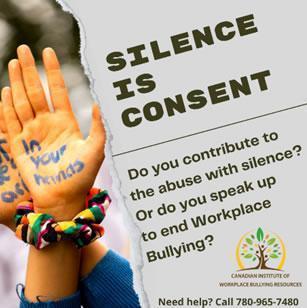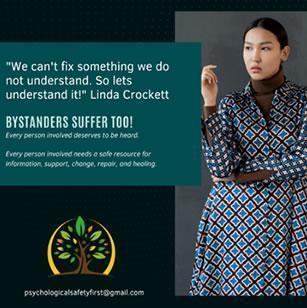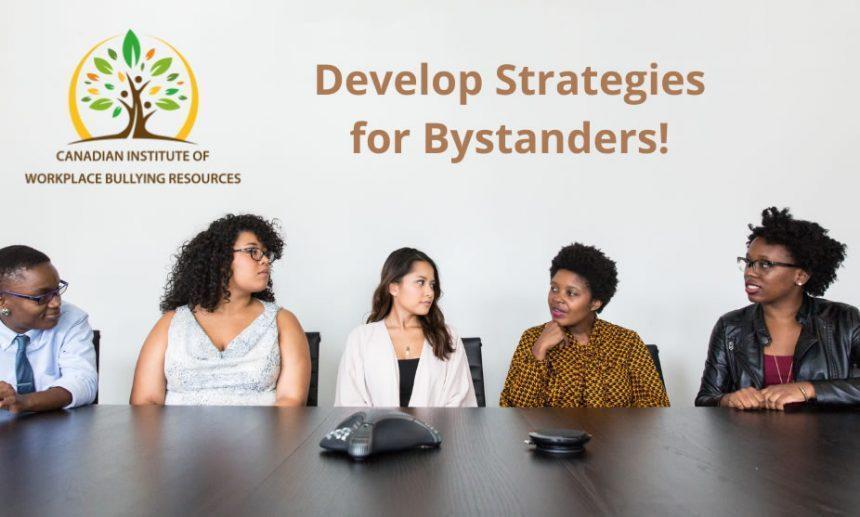by Linda Crockett, MSW, RSW, SEP, CCPA, founder of the Canadian Institute of Workplace Bullying Resources
Employees who are targeted by a bully at work, report that their witnesses did not come forward despite their promises, ethics, oath to report abuse, company policies, and legislation. This includes leaders and staff. Yet bystanders are vital to the prevention, intervention, and repair or recovery of a work environment, and for each of those who are harmed. Without witnesses, millions of cases are deemed “unsubstantiated.” This does not mean that “something didn’t happen!” First of all, we are seeing far too many cases left unsubstantiated, and secondly, they are being left without appropriate interventions in place to protect the complainant(s), or perhaps to protect the respondents who are being falsely accused! We must do more to support the witnesses. This is for the overall safety and reputation of the organization.
“Bystander intervention is known to be the most effective strategy when dealing with harasser or bully.”
R Hitlan, K Schneider and A Estrada, Reactions to personal and bystander sexual harassment experiences (2002).
Our clients, they ones who are targeted, always state that they cannot make sense of their colleagues/friends (witnesses) inaction? They feel betrayed and further injured. They wonder if they care or are they just cold hearted? They ask, “how do they sleep at night?”
Dynamics within the workplace will either support or prevent fellow employees from intervening to stop destructive, unprofessional, harmful behaviour. It is crucial for all employees, especially leaders, to become aware of the witnesses (or their own), individual barriers to reporting the abuse they witness. Leaders are role models and all employees’ eyes are on you, watching and waiting for you, their leader, to give direction, take action, or show inaction. It is important for leaders to set the tone of the work environment the wish to achieve.
Example:
Imagine a witness reporting workplace psychological harassment, including providing clear evidence. Next thing you know staff learn that this witness is mysteriously terminated ‘without cause’. This is not the tone of safety, protection, respect, and it will not motivate employees to be loyal or productive. We can assure you research shows that this tone costs employers hundreds of thousands to millions each year
Unfortunately, toxic organizations will find ways to retaliate and clean house of those who do not fit in to their toxic soup! If you become a threat to their cover up – or denial – they will make it rough on you. Be sure you know how to protect yourself. Do not hesitate to ask for help!
Imagine the savings from setting a tone of a psychologically safety work environment! Imagine the loyalty, dedication, hard work, and productivity you will receive from workers when leaders do the right thing! Make is safe for witnessed to come forward. Make it the right thing to do.
Why Do Bystanders Stay Silent?
There are many reasons why witnesses ignore a colleague who is being bullied, sexually harassed, or otherwise mistreated, especially where the perpetrator has the authority to negatively impact their career and reputation.
A lack of knowledge: training for all employees needs to be mandatory. There are many incorrect assumptions, myths, and a negative stigma preventing men and women reporting what is happening to them or reporting what they are witnessing. In-depth, trauma informed training is necessary for these complex, insidious cases of psychological harassment.
Training will help employees with prevention, intervention, restoration, repair, and recovery.
- Learn to identify the signs, symptoms, risk factors, characteristics, causes, profiles.
- What to do about it, what are your rights, where to go, who to speak to, what to say.
- Learn about how to respond, collecting evidence, protecting your mental health.
Workplace bullying has been ‘normalized’ in the eyes of many employees. Especially when they repeatedly witness the offender being rewarded (e.g., promoted), or leaders are silent’. Toxic leaders and/or staff have very keen skills to emotionally manipulate selected employees. They will weave a deceitful narrative to gain support and silence. Toxic employees might also slowly isolate people from those they are targeting. Many witnesses have no idea they are being groomed.
Why would a witness feel safe reporting? Many have reported and then became the next target. Especially when the toxic employee(s) use implicit or explicit threats against anyone who helps the targeted employee. For example: suddenly the witness is under a performance management plan, or repeatedly (subtly) told they can be replaced.
Why would a witness report abuse when the complaint process has failed time and time again? Who would jump in when the sharks are circulating? What if the bystander has barely recovered from being the one who was targeted in the past?
Some employees desire a specific (toxic) leader or colleagues’ approval. It may be because of their own fears (e.g., avoid conflict), or insecurities (toxic people can be very charming, popular, and outgoing), they may wish to be part of a popular group. Identifying their actions, non-actions, choices, and decisions, will require self-honesty. Self honestly requires self-insight.
Bystanders play a crucial part within the dynamics of workplace psychological harassment and/or psychological violence. They have the power to end it or, they can make it worse for those who are targeted. With decades of research offering clear evidence that business owners are losing millions of dollars each year due to unresolved bullying, it seems that ‘money is not doing the talking’ for thousands of business owners. Today we are however, seeing more and more toxic workplaces being exposed on social media. The cost of exposure just might shift the trend over the next year
Solutions
The voice of witnesses is the solution. Instant preventions and improvements will be made when bystanders come forward. Review your policies and procedures, enhance the message of safety for employees to come forward. Leaders must consistently role model zero tolerance.
Ensure that all leaders are on board with this commitment, increase protection for witnesses and whistleblowers:
- develop a safe reporting process and include alternative reporting options, just in case for example, the bully is their boss, the boss’s boss, HR, or safety officer.
- Use trauma informed, trained investigators with experience. Remove all risk of bias!
- Collaborate with qualified resources e.g., workplace consultations, trainers, coach/therapists. Whether cases are substantiated or not! Something happened!
- Do not stand by and watch – at very least -commit to documenting the details.
- Make it clear you will not be involved in negative behaviours.
- Reframe from hurtful teasing, gossip, and ostracizing employees.
- Do not acknowledge, reply or emails, text messages, or photos, that could cause harm.
- Consider the impact on your own health for not reporting and carrying this stress. Consider your own self-respect, dignity, and pride.
What Should Bystanders Do?
Ask for confidential ‘experienced support’ to help identify your personal barrier to reporting.
Know that your feelings and reactions are normal, understandable, and that you need to share, be heard, and given the right attention. There are answers for everyone. We just may be in too deep to see them.
Document whether you plan to report the abuse or not. Things will likely change in the future and if you become part of an investigation, your notes will be needed to help you prove that “you are a credible employee”. Without notes you may forget critical details. Keep your notes a) up to date, b) off site and secured c) do not include client names or details, and d) keep it all in one location e.g., a binder.
Review your policies, procedures, and take the steps that are outlined. However, if you are unsure, or you do not feel safe approaching anyone, seek outside support to develop a strategy that is best for you. We are available for you in Canada. If you are outside of Canada, we can refer you to someone in your area. If the case includes sexual assault, report it to the police. Call us if you need help.
If the bullying is occurring online, report it to the owner of the website e.g., Facebook, Twitter, or Linkedin, have processes for reporting incidents.
If You Would Like to Support, the Employee(s) Who is Targeted
- Advise them that you saw what happened. Validate that this was difficult to see, unfair to the target, unacceptable abuse, unprofessional, and that they did not deserve that treatment.
- Remind them to document immediately, review their policies, and procedures, and to seek help. Tell them they are not alone. See their doctor, or a workplace coach/counsellor who can guide them and help them.
- Share our website with them. It is unlikely that the bullying will just end. Denial or avoidance will never help. Meantime, there are safe resources and steps to become aware of.
Leaders are responsible to keep all employees physically and psychologically safe. Psychological harassment (bullying) is a workplace hazard. It is more than the ethics. It’s more than being professional. It not only makes good business sense, it is Canadian Provincial and Federal Law!
Make it mandatory for all leaders to take in depth trauma informed training on this topic.
Be sure to have a cohesive, competent, confident set of leaders. Train, monitor, and mentor your leaders. Set leaders up for success. Research says up to 74% of bullying at work is coming from top down. Fix that statistic and you fix it all! Leaders who practice zero tolerance will not tolerate from bottom up or laterally!
Bullying will be gone when all leaders make to so!
Become Informed! Don’t cut corners! It costs twice as much or more when you do.
Contact us today to start working with our qualified specialists.





